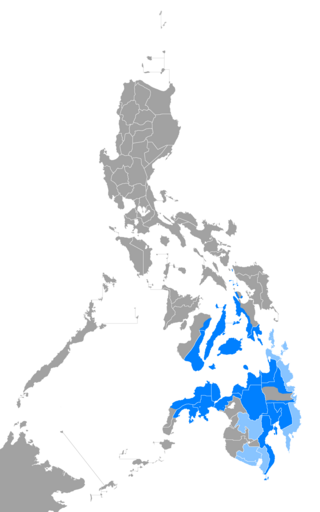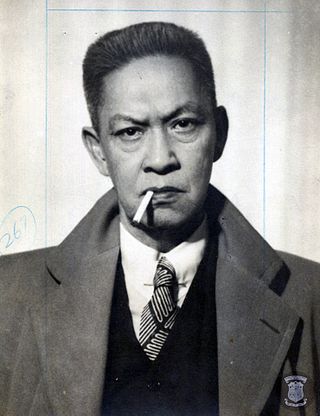Related Research Articles

Cebuano is an Austronesian language spoken in the southern Philippines. It is natively, though informally, called by its generic term Bisayâ or Binisayâ and sometimes referred to in English sources as Cebuan. It is spoken by the Visayan ethnolinguistic groups native to the islands of Cebu, Bohol, Siquijor, the eastern half of Negros, the western half of Leyte, and the northern coastal areas of Northern Mindanao and the eastern part of Zamboanga del Norte due to Spanish settlements during 18th century. In modern times, it has also spread to the Davao Region, Cotabato, Camiguin, parts of the Dinagat Islands, and the lowland regions of Caraga, often displacing native languages in those areas.
Epifanio Alfafara (1882–1933) was a Filipino Visayan writer in the Cebuano language of political and philosophical articles. He used Isco Anino as a pen name.
Tomás N. Alonso is a well-known Cebuano Visayan writer. He published the first complete Cebuano translation of Jose Rizal's El filibusterismo. He also translated the Mi último adiós. He was a columnist with Bag-ong Suga and editor of the Spanish publication La opinión.
Uldarico Aguilar Alviola Sr. was a Filipino Visayan civil servant, novelist, and editor from Cebu, Philippines. While he wrote in English and Spanish, his published works in the Cebuano language earned him the title "Dean of Cebuano Writers."

Sergio "Serge" de la Rama Osmeña III is a Filipino politician and legislator who served as a Senator of the Philippines. He is a grandson of the 4th president of the Philippines, Sergio Osmeña. In his eighteen years in the Senate, Osmeña chaired the most committees and filed the most bills in the history of the institution.

Vicente Yap Sotto was a Filipino playwright, journalist, and politician who served as a senator from 1946 to 1950. He also served in the House of Representatives from 1922 to 1925, representing Cebu's 2nd district. He was the main author of the Press Freedom Law.
Cebuano literature includes both the oral and written literary forms Cebuano of colonial, pre-colonial and post-colonial Philippines.
Alfafara is a surname. Notable people with the surname include:

Vicente Rama was a Filipino Visayan legislator, publisher, and writer from Cebu, Philippines. Recognized as the Father of Cebu City, he authored the bill for its cityhood which was approved into law by October 20, 1936. He also founded the leading pre-war Cebuano periodical, Bag-ong Kusog.
Nicolas Rafols y Mercado was a Filipino Visayan legislator, journalist, businessman, lawyer, and agriculturalist from Cebu, Philippines. He was a member of the House of Representatives for Cebu's 6th District for multiple terms.
Vicente Ranudo was a Filipino Visayan writer, poet laureate, and Cebu provincial civil servant. He wrote for various pre-war periodicals, including the first Cebuano newspaper Ang Suga, and was considered the father of Cebuano poetry.
Natalio Bacus Bacalso was a Filipino writer, newspaperman, radio broadcaster, filmmaker, Constitutional Convention delegate in 1971 representing Cebu's 2nd district, and opposition assemblyman to the Interim Batasang Pambansa in 1978. The Natalio Bacalso Avenue is named after him. On June 13, 2019, The Freeman recognized him as one of the Top 100 Cebuanos.
Amando Navarette Osório (1890–1946) was a Filipino Visayan poet, playwright, novelist, and Cebu deputy governor. His novel Daylinda, Ang Walay Palad was the first historical fiction in Cebuano literature and the third novel written in Cebuano language.
Marcelino M. Navarra was a Filipino Visayan editor, poet, and writer from Cebu, Philippines. He was regarded as the father of modern Cebuano short story for his use of realism and depictions of fictionalized version of his hometown, barrio Tuyom in Carcar, Cebu.

Manuel Cabahug Briones was Filipino Visayan lawyer, judge, and politician from Cebu, Philippines. He was the first Supreme Court Associate Justice from Cebu, and he was a former Associate Justice of the Court of Appeals, two-term Senator, Member of the House of Representative for four consecutive terms, and editor from Cebu, Philippines.
Pedro T. Lopez was a Filipino Visayan lawyer, writer, and legislator from Cebu, Philippines. He founded the Cebuano periodical Nasud (Nation), elected as Congressman during the 1st Congress of the Commonwealth in 1945, and member of the 3rd Congress of the Republic for Cebu's 2nd district. In 1946, he was appointed to the Philippine Rehabilitation Commission, delegate to the first United Nations General Assembly, and associate prosecutor International Military Tribunal for the Far East.
Florentino D. Tecson was a Filipino Visayan lawyer, politician, editor, writer, and labor leader from Cebu, Philippines. He edited pre-war Cebuano periodicals such as Bag-ong Kusog and published his own newspaper, Ang Mamumuo, and a book of fiction, Lingawon Ko Ikaw. A known labor leader, he was the president of Federacion Obrero de Filipinas. He served as councilor of Naga and Cebu City and was appointed as Vice Mayor of Cebu City (1954–1955).
Pio Abelgas Kabahar, also known as Piux A. Kabahar, was a Cebuano composer, playwright, journalist, and director. He was best known as a playwright, he was the director of the first Cebuano moving picture, Bertoldo ug Balodoy.
Ernesto Degumbis Lariosa, also known as Nyor Erning, was a Filipino Visayan writer, poet, and columnist from Cebu, Philippines and a three-time Palanca awardee in Cebuano short story. In 2003, he was recognized by the Cebu City government as the "Vanguard of Cebuano Literature".